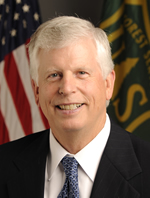Tidwell was in Southeast Alaska last week (8-28-13) for a review of the Forest Service’s regional operations. The hands-on review by agency officials takes place about once every seven years.
Listen to iFriendly audio.
Speaking to reporters during the review, Tidwell said that the Forest Service was still focused on building sustainable economies in timber and minerals throughout the nation, but that it valued its partnerships with conservation groups for restoration work.
Without partnerships, Tidwell suggested that the work might not get done.
“We’ve got to be able to expand our capacity. And we can’t always rely on appropriated dollars, because those have continued to go down. Our staffing’s gone down, but at the same time our resource needs — to be able to restore these systems — that hasn’t gone away. So we’re reaching out to conservation groups and all our different partners to find more ways to be able to build capacity, so that we can meet the needs of the public and the needs of our communities. It’s one of the ways that this region is responding to that need, with the realities that we have a lot less people, a lot less resources, than what we’ve had in the past.”
Sitka District ranger Carol Goularte told the Sitka Assembly on August 13 that staffing in her office had dropped from 137 employees in 1996, to 63 now. She said there were plans on the board to possibly drop that number further, to 42.
Not many timber sales have been planned out of the Sitka District recently, but several large restoration and young growth projects — in Sitkoh Bay, Starrigavan, and FUBAR Creek — have all had significant participation by district staff.
The actual restoration work — the boots on the ground — is being funded through collaborations of various conservation groups like Trout Unlimited, the Sitka Conservation Society, and the Nature Conservancy.
SCS director Andrew Thoms was selected to sit on a panel on young growth and restoration during the chief’s review.
“I think that we expected that the Forest Service would make a quicker transition into a new management focus on fisheries, watershed restoration, investments in the visitor industry and recreation and tourism, a larger focus on subsistence management. Rather than this same old focus on the old logging program on the Tongass.”
In 2009, Secretary of Agriculture Tom Vilsack announced a far-reaching vision for the Forest Service along these lines, but Tidwell’s sights are on the more traditional realities of the agency, and anchored by logging.
“It takes a combination of not only what we can do to provide great fisheries habitat in streams, but to be able to respond to the need for minerals development, to respond to the needs for hydro development, to be able to continue to provide a sustainable flow of timber, that can provide an industry that we can sustain over time.”
The Sitka Conservation Society’s Andrew Thoms said the young growth and restoration panel concentrated on fisheries, where SCS and other organizations have been stacking a lot of their chips lately. He thinks the message was delivered.
“I think one of the biggest eye-openers for them was the salmon, and that the Tongass is really a salmon-producing forest. I know that some of the members of the contingent that was here got to go out fishing — coho fishing — and they saw all of the trollers, hundreds of small businesses that operate on the Tongass, and the charter operators that were taking visitors out catching these coho salmon — 80-90 percent of which come from the Tongass National Forest.”
The amount of fishing businesses that the Tongass sustains, Thoms added, “Is something that people from outside the region don’t understand.”
In addition to Chief Tidwell, the other member’s of the chief’s review included the Forest Service’s senior management from Washington DC.
Thoms says that conservation groups like SCS have willingly partnered with the Forest Service in restoration, but that the time has come in the transition for the agency to take a greater leadership role.
KTOO’s Matt Miller contributed to this story.































